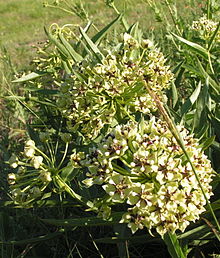Asclepias asperula
| Antelope horns | |
|---|---|

| |
| Scientific classification | |
| Kingdom: | |
| (unranked): | |
| (unranked): | |
| (unranked): | |
| Order: | |
| Family: | |
| Subfamily: | |
| Genus: | |
| Species: | A. asperula
|
| Binomial name | |
| Asclepias asperula | |
| Synonyms[1] | |
| |
Asclepias asperula is a species of milkweed native to the Southwestern United States and northern Mexico. Its common names include Antelope horns, green-flowered milkweed, and spider antelope horns.
Description
It is a perennial plant growing to 0.6–2 m (1–2 feet) tall, with clustered greenish-yellow flowers with maroon highlights. It blooms from April through June, and favors moist, sandy or rocky soil.
Monarch butterflies
Like several other species of milkweed, A. asperula is a food for monarch butterfly caterpillars. Along with being a source of nutrition for monarchs, the plants also contain toxic cardiac glycosides (Cardenolides) that the monarchs retain, making them unpalatable and poisonous to predators. For the same reason, A. asperula can be poisonous to livestock and other animals, including humans.
References
- ^ "The Plant List: A Working List of All Plant Species". Retrieved 12 April 2015.
